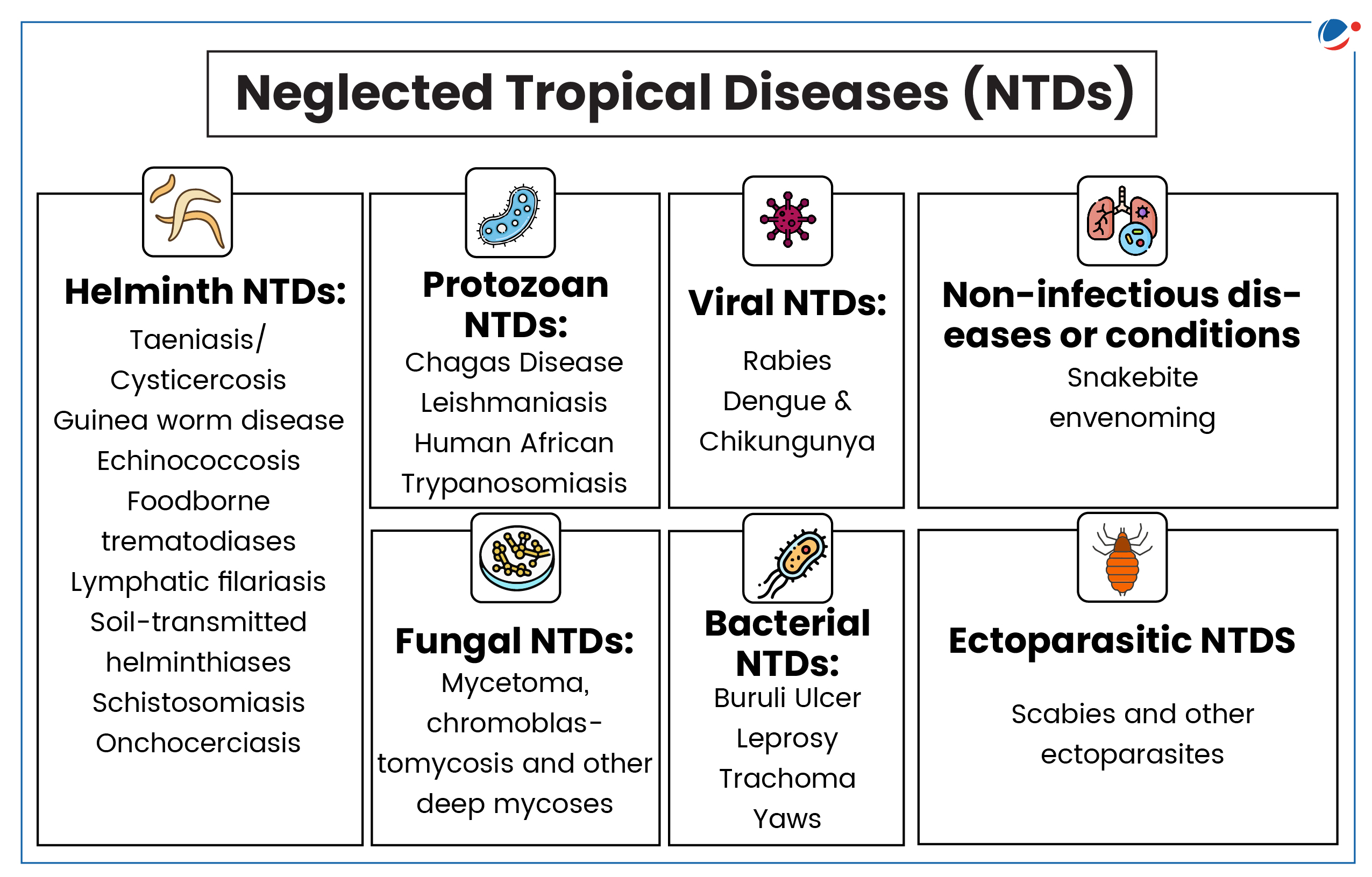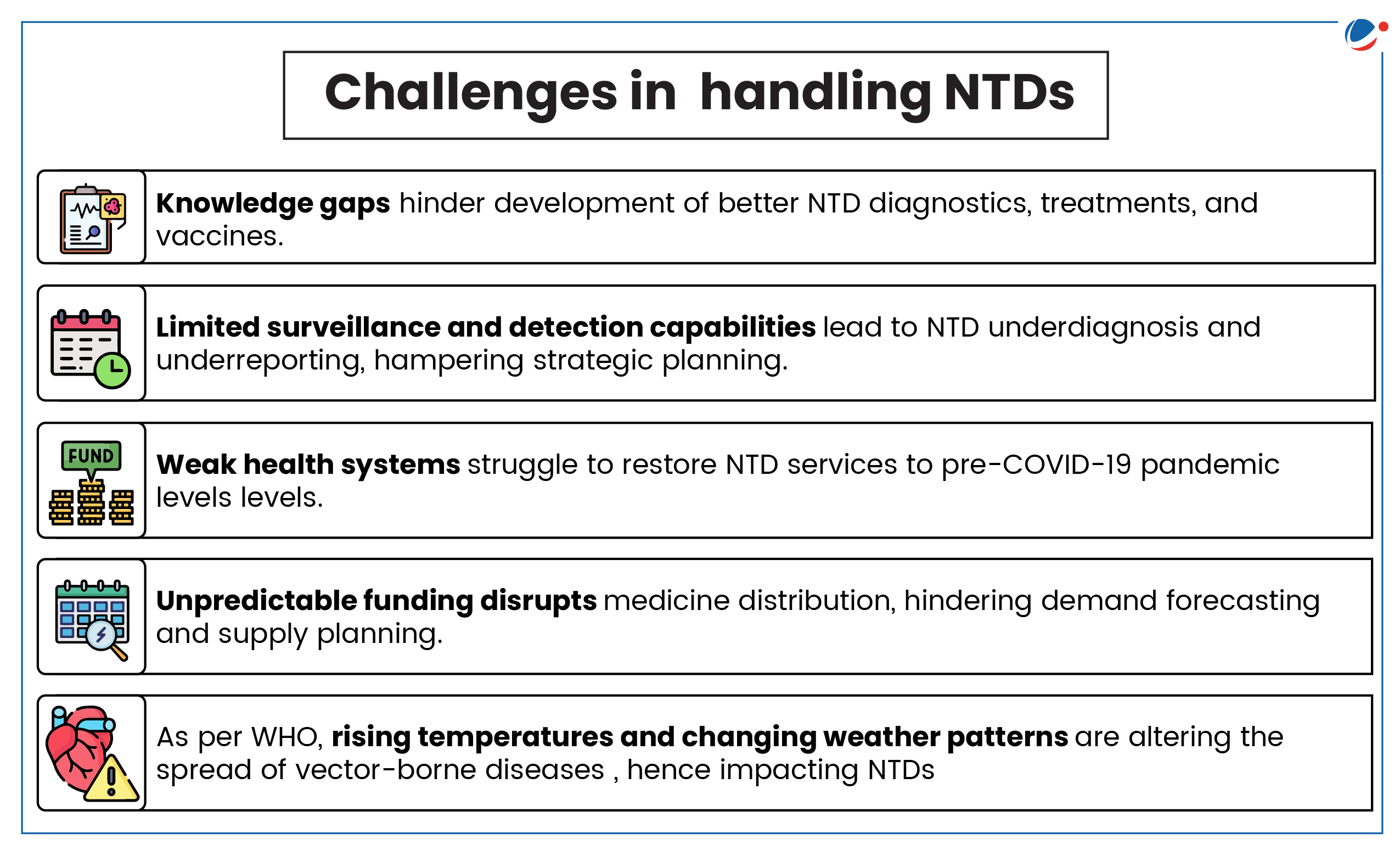Why in the News?
World Health Organization has recently published report titled Global report on Neglected Tropical Diseases 2024.

More about the report
- The report offers an update to WHO member states and international partners on the advancements achieved in 2023 towards the implementation of the Road map for neglected tropical diseases 2021–2030.
Major Progress against road map indicators highlighted in report
- Reduce the percentage of people requiring interventions against NTDs by 90% by 2030.
- In 2022, 1.62 billion people required interventions against NTDs, a 26% decrease from 2010.
- Reduction in vector-borne NTDs related deaths by 75% by 2030.
- The number of deaths related to vector borne diseases increased by 22% in 2022 compared with 2016.
- 100 % access to at least basic water supply, sanitation and hygiene in areas endemic for neglected tropical diseases by 2030.
- In NTD endemic countries, 85.8% have access to water/sanitation/hygiene overall, but only 63% of those requiring NTD interventions.
Findings related to India
- About 40% of people require interventions against NTDs in India, which is highest in the world.
- WHO certified India as free of Guinea Worm disease (2000) and Yaws (2016).
Neglected Tropical Diseases (NTDs)
- NTDs are a diverse group of conditions mainly prevalent in tropical areas.
- They are caused by a variety of pathogens including viruses, bacteria, parasites, fungi and toxins.
- Called Neglected because they are almost absent from the global health agenda, Low global funding and associated with stigma and social exclusion.
- NTDs have historically ranked very low and almost absent from the global health policy agenda – only to gain recognition in 2015 with the Sustainable Development Goals (SDG target 3.3).
- India has the world's largest absolute burden of at least 10 major NTDs- hookworm, dengue, lymphatic filariasis, leprosy, kala-azar and rabies, ascariasis, trichuriasis, trachoma and cysticercosis.

Why eliminating NTDs is important?
- Affecting large Population: As per WHO, NTDs impact over 1 billion people globally, with 1.6 billion needing preventive or curative interventions.
- NTDs disproportionately affect poorer nations, with 80% of the disease burden concentrated in low- and middle-income countries.
- Socioeconomic Impact: WHO estimates that eliminating NTDs by 2030 would save affected individuals over $342 billion in healthcare costs and productivity losses.
- Indicator of Universal Health Coverage: NTD interventions are often at the frontline of public health and are considered important steps on the path towards achieving universal health coverage by 2030.
- Affecting Gender Equality: NTDs can impact women's economic productivity due to health complications such as pregnancy-related complications, anaemia, etc.
- For E.g. Female genital schistosomiasis affects an estimated 56 million women, increasing HIV risk and causing organ damage.
- NTD control yields high returns: An NTD investment case for ending NTDs published in 2017 estimated that preventive chemotherapy treatments yield $25 in benefits per $1 invested.

Steps Taken
Global
- Global NTD Annual Reporting Form (GNARF): Standardized document used by countries participating in the Global NTD Programme, introduced by WHO in 2023.
- Global vector control response 2017–2030 (GVCR): Provides a new strategy to strengthen vector control worldwide through increased capacity, improved surveillance, better coordination and integrated action across sectors and diseases.
- Others: Kigali declaration on NTDs (2022); Strengthening NTD structures and cross-sectoral collaboration; Public–Private Partnerships, etc.
India
- National Vector Borne Diseases Control Programme (NVBDCP): For prevention and control of vector borne diseases namely Malaria, Japanese Encephalitis, Dengue, Chikungunya, Kala-azar and Lymphatic Filariasis.
- Others: Vector-control measures such as Indoor Residual Spraying rounds; Wage compensation schemes by State and central governments to Kala-Azar patients, etc.
Way forward
- Key recommendations given by 'Global report on neglected tropical diseases 2024'
- Accelerate programmatic action (Pillar 1): Reduce incidence, prevalence, morbidity, disability, and death
- Intensify cross-cutting approaches (Pillar 2): By Integrating interventions, mainstream services, and coordinate action on programmes.
- Change operating models and culture (Pillar 3): Increase country ownership and align stakeholders' roles to meet 2030 targets.
- Integrating NTDs into the Broader Global Health Landscape: Repositioning NTDs within the global health agenda by building links with other global programmes (e.g. health emergencies), crosscutting approaches (e.g. One Health), emerging global priorities (e.g. climate change).
- Strengthen Regional Partnerships: Help to handle NTDs effectively such as South-East Asia Region bears the highest burden of dog-mediated human rabies in the world, this can be effectively eliminated with regional cooperation.
- Holistic multi-sectoral actions: Need a comprehensive approach that includes veterinary public health, improved water and sanitation, expanded vaccine access, food safety measures, vector control, and effective communication strategies to eliminated NTDs.
- Filling normative and operational gaps: To ensure that strategic approaches are constantly refined to meet the challenges faced by programmes.
- Increasing Funding: Maintaining and expanding the partner/donor community, by nurturing existing relationships and creating new ones.








